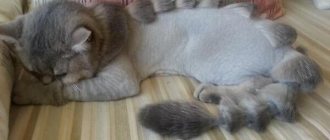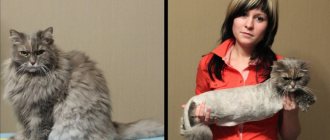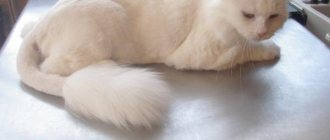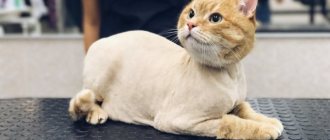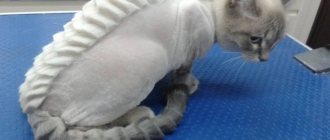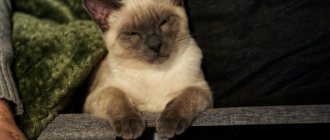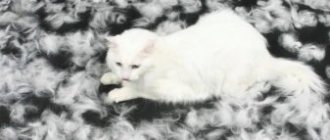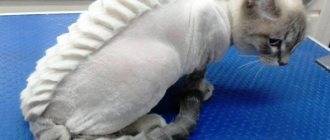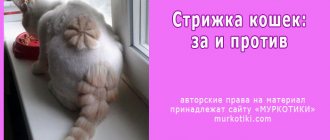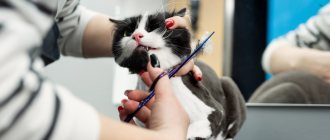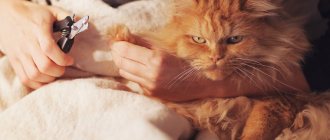Grooming a domestic cat on your own is a very difficult and responsible task. For a handsome furry cat, such an event, conducted illiterately and unprofessionally, can turn into real stress. If you still decide to do the haircut yourself, without the help of a professional hairdresser and at home, then you should first familiarize yourself with the recommendations of professionals so as not to harm your pet.
How often
Experts recommend cutting your hair several times a year.
For ordinary cats, 1-2 times a year is enough, for long-haired cats 3-4 times. Haircutting largely depends on the formation of tangles. The influence of the owner who decided to win with the help of a cat at an exhibition is decisive. But veterinarians do not recommend abusing the procedure. Long-haired cats can be trimmed before the start of summer to improve heat exchange. For medicinal purposes, the hair is shaved as needed. Let us note some of the nuances that accompany any haircut:
- You cannot cut your head, the hair on your paw pads, and especially your mustache. The fur in the ears performs a protective function. You can't touch her either. Without it, dirt and dust will accumulate in the ears.
- Haircuts often cause the fur to change color after it grows back. It is not recommended to cut cats with kolopoit and tipping. The fur becomes noticeably darker on the back and belly.
- The fur grows back up to six months. Frequent haircuts can cause hair to not grow to the desired length. The coat will become thinner, which is fraught with potential diseases during the winter.
- To be safe, you should trim your cat's claws first. It is worth carrying out the procedure with an assistant.
- Getting a haircut, especially for the first time, is not a quick process. They last at least 2-2.5 hours.
In specialized hairdressing salons, specialists use mild anesthesia. But its frequent use has a negative impact on the pet’s health. It is possible to do a haircut at home without anesthesia.
How does a cat change after a haircut?
Be prepared for the fact that after the procedure, the original coat color of long-haired animals will change somewhat (it will become a little darker or lighter). In some cases, haircuts also affect hair growth: it becomes more intense or slows down somewhat.
If this hygienic measure is carried out correctly, the cat’s behavior will not change, however, with rude and careless actions, the animal may experience severe stress, which will subsequently make it more fearful and distrustful of its owner.
Recommendations for different cats
Grooming a cat with soft, long hair at home is not at all easy. The machine does not grip the hair well and slips. It will take a lot of patience, and each section must be walked several times in one direction and the other.
What to do with the Persians
Sedate and docile cats of the Persian breed experience enormous stress during grooming and are able to show their claws. Therefore, it is better to invite an assistant. The classic version of haircut for Persian cats is “puss in boots”, when the head, paws and partly the tail remain untouched.
Grooming a British breed cat
It is not customary for British people to cut their hair. Their fur is short and mats rarely form. It is enough to regularly remove guard hairs with a bristle or rubber brush. The undercoat is then not damaged, and the coat looks well-groomed.
How to deal with tangles
To combat tangles, there is a special tool - a tangle cutter. It can be replaced with scissors. It is necessary to place a comb under the mat so that when cutting off the matted fur you do not injure the cat.
Haircuts for furry pets
For fluffy and long-haired pets, there are simple French Lion and Puss in Boots haircuts. More complex options for craftsmen are “modern” and “harlequin”.
Advantages and disadvantages
Buying a clipper is beneficial for ordinary animal lovers, owners of purebred cats, breeders and groomers. But this technique also has a number of disadvantages associated with the characteristics of its individual varieties and the quality of inexpensive models. For ease of comparison, all the pros and cons are summarized in a table.
Positive aspects Negative nuances Saving on professional services. You can cut your pet's hair yourself and completely free. This is especially important if there is more than one four-legged family member in the house. Some animals are very afraid of even the quietest appliances, which forces owners to switch to mechanical machines. Reducing stress. At home, animals are less nervous and resist, so the result will be better: smooth, short hair, no injuries on the pet’s skin and human hands. You need to adapt to manual models so that the haircut is smooth and the process does not take too much time. Autonomy The wireless battery model can be taken on a trip, for example, to an exhibition. The cable of a wired clipper may be too short, interfere with the hairdresser, or distract the cat. Quality of haircut. With scissors it is difficult to achieve the same effect that any machine, even a manual one, can give. If the kit only includes basic attachments, additional attachments will have to be purchased separately, which will significantly increase costs. Safety
The special device will not harm the cat if the instructions and precautions are followed. A human clipper can cause pain to an animal, even if used very carefully. Cheap devices pull and pull hairs, injure the skin, their blades quickly become dull, and the devices themselves can fail after several haircuts. High-quality machines are not cheap. The battery charge may not be enough for the entire procedure
How often should you get a haircut?
The frequency of grooming cats, photos of which can be offered at a pet salon, depends on the structure and length of the animal’s fur.
If you want to cut your cat's hair less often, you need to brush it more often. The areas where mats most often form are the armpits, the area between the hind legs, behind the ears, on the neck and tail.
Some people believe that grooming is not necessary, just cutting off the tangles in time is enough. Yes, you can do this, but then the aesthetics of the animal’s appearance will leave much to be desired. It is also dangerous because tangles form in areas where the skin is very delicate, and cutting them off can injure the animal. After all, sometimes it is quite difficult to distinguish where the skin fold ends and the tangle begins.
Review of popular cat clippers
Let's consider several models from the most popular manufacturers. This will allow you to make the best choice for your pet's grooming needs.
Moser 1400–0075
Popular German device for grooming animals. It is presented with a full set of attachments and cutting tools. The Moser 1400–0075 is easy to store and use. The appearance of the device is classic, which will appeal to many. Considering the very reasonable price, which is about 4 thousand rubles, this will be an excellent purchase.
Moser 1400–0075 - a popular German model with convenient packaging
OSTER Grooming Kit 220 W
This short hair clipper is perfect for home use. The kit includes several attachments, but all of them, one way or another, are intended for animals with short hair. The price of the device is approximately 5,500 rubles.
OSTER Grooming Kit is a device for grooming animals with short hair.
Choosing a cutting tool
The owner often has questions. How and with what do fluffy cats get their hair cut? Is it better to cut hair at home with scissors or a clipper? How to make a beautiful haircut yourself? But first things first.
Sometimes they use a machine, which is undoubtedly convenient, but the loud noise can greatly frighten your four-legged pet. This is perhaps one of the main criteria when choosing a tool. Let's note other devices that are useful for a competent haircut:
- Hydrogen peroxide, iodine, bandage - in case the cat gets hurt while grooming.
- Comb – will allow you to tidy up your cat after grooming.
- A towel or rag that should be placed on the floor or table so that hair is not scattered throughout the apartment.
- If necessary, a toy to distract the cat from grooming.
- Trimmer for cutting hard-to-reach places.
- For haircuts at home, an assistant is most often required. Especially if the cat is not easy to handle.
If scissors are used for cutting, they must have rounded ends. But let’s leave this tool, after all, cutting with scissors requires a certain skill
Let's pay attention to the choice of machine
The first thing you should pay attention to when purchasing is the price. You shouldn't skimp on cheap machines. It is preferable to buy a more expensive tool that will last longer than a Chinese fake. But not only service life is important. A cheap clipper most often causes pain to the cat by shaving off the hair rather roughly.
If it is not given, then after the first haircut, which is given with great difficulty, the cat will be afraid not only of the clipper, but also of the haircut in general.
For Persians and other long-haired breeds, you will need a powerful machine. The blades must be sharp and wide enough to effectively remove matted fur. The power of the machine should be at least 45 Watt; for other breeds, 20 Watt is suitable.
The best option would be a machine where you can adjust the size of the blades. Working length – 2-3 cm, with an error of 0.5 mm. Preference in choosing should be given to a machine where you can adjust the size of the blades without replacing them.
To make work easier, the machine must be powered. Batteries have a habit of dying at the most inopportune moments. Working from the network will allow you to properly carry out a haircut at home. Take the necessary breaks and shave for as long as you like.
In extreme cases, a regular mechanical machine will do. Among the minuses, we note the unevenness of the haircut and the long process compared to the electric one. The advantages, of course, are the tolerable price and minimal noise.
Required Tools
A hygienic grooming of a furry pet can be done using only scissors as the main tool. Naturally, they should have rounded ends, be well sharpened and not very large in size.
But it is preferable, of course, to use a trimmer (a special hair clipper). It is completely safe and you won’t be able to inadvertently injure your pet, and it does the job much faster and easier. The only problem that can become an obstacle is the noise the machine makes. Your pet may get scared of the device and simply run away. There are regular trimmers and ones for hard-to-reach places.
Additionally you will need:
- Comb with rounded teeth to avoid scratching the animal.
- Hydrogen peroxide and cotton wool in case you accidentally injure your pet.
- Bedding, for example, an old towel, which will have to be thrown away after the event.
- A table or couch is any horizontal surface where you can comfortably place your cat.
- A distracting object that the pet can engage in during the procedure, for example, a toy, a dental bone.
Which machine to choose for grooming a cat
Retail chains offer a very wide range of devices for grooming pets, from very expensive and functional to budget ones. The disadvantage of inexpensive models is, first of all, their unstable and indelicate operation - such models can cut fur poorly or pull out hair. Another disadvantage of budget models is that they overheat during use, and you can simply burn your pet. Inexpensive trimmers have a short service life.
As mentioned above, there are regular trimmers and ones for hard-to-reach places. The latest models are distinguished by their small size and shorter blades (no more than 2 cm). A similar device can be used to treat areas of anatomical curves, ears, muzzle, and areas under the tail. But this is more of an auxiliary tool; it is impossible to give a full haircut with it. Conventional trimmers are used for these purposes.
For representatives of especially fluffy breeds with a thick undercoat (Persians, exotics, etc.), choose devices with a power of at least 45 W, they will not overheat and can cope with thick hair.
Pay attention to the blades: they should be wide and sharp. The speed and delicacy of work depends on the sharpness of the blades
For cats with not very thick and long hair, you can use clippers with a power of 20 W or more.
A very useful option for the trimmer is the ability to automatically adjust the cutting surfaces
When choosing a device in a store, pay attention to this; not all models have this function. With a minimum length of cutting surfaces of 0.5 cm, the length of the pet's hair after cutting will be equal to 0.5 cm
It is dangerous to use devices with very small blades yourself at home - you can injure the skin of the animal.
Mains-powered electric trimmers are preferable to those that rely on batteries or a battery. They guarantee stable and long-term operation of the device. If you frequently have to pause and turn off the device while cutting, the battery or batteries may drain very quickly. An even more convenient option is models that have both a battery and a network connection.
The noise level produced by the device is also important. The quieter and more pleasant the device is, the more the cat will like it.
Make sure that the machine is comfortable to hold in your hands. It should be moderately light and moderately heavy.
It is difficult to ensure smooth movement with a device that is too light, and a device that is too heavy will quickly tire your hand. Therefore, try to find a “golden mean”.
Pay attention to the shape of the handle; it should fit comfortably in your hand and not slip out.
Be sure to check the device before purchasing, especially for overheating and foreign odors.
How often should you get your hair cut?
The frequency of such a hygiene procedure depends on the breed of the cat and its coat type. On average, a cat's hair grows back completely in six months. Most veterinarians recommend trimming your pet's hair for hygienic purposes several times a year. If your cat has hairballs, you can simply cut them out with scissors.
You should not overuse haircuts, because wool is the natural protective cover of many animals, especially in the cold season. If your pet does not tolerate manipulation with scissors and clippers, it is recommended to entrust this task to a professional: veterinarians in clinics know how to calm an aggressive animal and carry out the procedure quickly and in the least traumatic way.
It is best to trim long-haired animals before the onset of heat, since furry pets do not tolerate high temperatures well.
What diseases can be detected
A haircut can help identify various diseases that the pet owner didn’t even know about. Skin diseases (lichen, eczema and others), an abundance of parasites are often discovered after the grooming procedure. It helps to get rid of many problems; in addition, short hair is better washed with medicated shampoos.
The appearance of bald patches, peeling of the skin, redness, high body temperature are symptoms that grooming specialists pay attention to. The most common diseases include problems associated with the coat and skin.
If your pet intensively combs, licks, or bites its fur, it is worth shortening it and examining the skin.
Bald spots and rashes can be caused by ticks, lice, and fleas. Ringworm, mycosis, is dangerous not only for cats, but also for humans. A haircut allows you to recognize the disease in time and begin treatment. Cats are also susceptible to cancer, the symptoms of which may include dull fur, spots on the skin, and swelling.
How to cut a cat's hair yourself
Grooming cats is far from the easiest task, which will require a certain skill from the performer. Without minimal grooming skills and special tools, it is better not to undertake modeling a cat’s hairstyle, but to entrust this mission to a specialist. But if you still intend to trim your pet’s hair yourself, then you need to adhere to some rules.
Step-by-step instruction:
Get an assistant, or better yet two, who will carefully hold the cat. Place the cat on a specially prepared table; assistants should hold it by its paws. Carefully remove fur from the back and belly
At the moment when the wool is cut, it is necessary to stretch the delicate and thin skin so as not to injure it. Next, the helpers must hold the animal by the body with one hand and hold the paws with the other. Then you should carefully trim the hair on the paws and tail. After trimming is completed, the cat must be given a bath to wash off any small remaining lint. If there are scratches, then you need to treat the body of your pet or helpers with a suitable disinfectant (hydrogen peroxide, chlorhexidine and others).
What you need for grooming
If the owner of a pet intends to periodically trim his hair at home, then he will need to acquire all the necessary equipment for this. It's best to buy special tools from professional pet supply stores, but some hair salons will do the trick, too. The main condition is that all grooming equipment is safe.
Equipment for grooming a cat at home:
- A comfortable and stable table that needs to be covered with a thick blanket and a sheet on top.
- Hairdressing scissors with blunt ends (cutting and thinning).
- A machine with nozzle No. 3, which leaves behind a pile 3 mm long.
- An undercoat brush and a fine-toothed flat comb.
- Nippers for trimming nails.
- Hygienic products for bathing the client after a haircut.
Cat clipper
Grooming cats with a clipper greatly simplifies the process of accurately and quickly removing the fur. But when selecting such a device, you need to provide some features for high-quality and safe grooming of your pet. When choosing a machine, preference should be given to a device with ceramic blades, because they are more durable and do not heat up as much as steel ones. The device should be as silent as possible so as not to frighten the cat. The kit should contain attachments for piles of different lengths.
How is it going?
If a haircut is necessary, it begins after treating the claws and injecting a special preparation.
For cutting, use a clipper and scissors, paying special attention to the armpits and abdomen. At the end of the haircut, the animal is bathed, its fur is dried, after which it is combed out.
You need to wash your cat well so that there are no cut hairs left on his body.
The specialist selects a washing shampoo and begins bathing the cat. After bathing, he wraps her in a towel to dry her fur. Other masters use a hairdryer to speed up the procedure. If necessary, a haircut is performed, which is selected based on the length of the coat and the preferences of the owner.
Sometimes pets need trimming, which involves comprehensive hair care with the removal of old hair and cutting out specific hairs. For example, some individuals have the hair between their toes trimmed.
This should be done carefully so as not to injure the animal. When doing ear and eye hygiene, the master will tell the owner that this needs to be done daily
If the cat has diseased organs, antiparasitic treatment is performed to remove purulent discharge. If the wool is matted, they are removed, the wool is combed for a long time, using different combs and brushes
If the cat does not have hair (hairless breed), instead of cutting and combing the fur, the master pays attention to places where dirt may accumulate in the folds of the skin. These cats need frequent baths
As for the ears and eyes, they are cleaned using chamomile infusion or boiled water. Earwax discharge is removed using a damp cotton swab or disk. Get rid of dust particles and dirt in the corners of the eyes using wet wipes soaked in boiled water. The claws are trimmed with a nail clipper to no more than 1.5 mm.
As for removing tartar, this should only be done by a specialist. Ideally, you need to brush your cat’s teeth with a special paste and brush every day. However, it is rare that a breeder can do this on their own, and not everyone knows that the paste for cleaning cats’ teeth is different from the one that people use.
For information on the features of cat grooming, watch the following video:
Do-it-yourself cat grooming at home
If your main requirement is to give your cat an inexpensive haircut, you can always shave him at home. To do this, it is better to buy and use special tools, rather than an ordinary mechanical razor from your own arsenal. In order for the fur to continue to grow properly, it is advisable to start the process with consultation with a specialist. The rest of the sequence of actions of the breeder is as follows:
The first step is to immobilize the pet by holding it by the front and hind legs and laying it on its side. This is the only way to cut a cat's hair, otherwise he simply won't let you handle it. Aggressive long-haired breeds are recommended to wear a special collar during the grooming period. It is recommended to carefully cut off large tangles with scissors, after giving the cat a sedative. The owner must act carefully, since such actions in any case provoke stress for the pet. Before you trim your cat, you need to sharpen the scissors. After scissors, you need to use a razor to remove the hair from the sides, back, and then partially from the paws
It is important to avoid intimate areas and nipples, otherwise injury to them can cause serious illness for the animal. The tail can be trimmed last if the hairdresser wishes, but you don’t have to experiment. It is recommended to remove cut hairs stuck to the body with a damp cloth, but you should only use a hairdryer if absolutely necessary.
Such a device, or rather the stream of hot air it produces, causes severe stress in the animal.
How to trim an aggressive cat's hair
- It is not useful to administer anesthesia to an animal before grooming; in case of increased aggression, it is better to use an approved sleeping pill.
- To prevent the cat from scratching its owner, its claws must be cut. Don't worry, as they will be able to grow back within a week.
- At home, if your four-legged friend is showing increased aggression, it is advisable to use a special collar, otherwise the cat may bite the “barber.”
A professional machine is the best assistant for a novice groomer
The choice of different tools for cutting wool is huge. The temptation to save money is great: why pay 5,000 rubles when you can buy the same thing, but five times cheaper? This is the main mistake that owners make. It is almost impossible to carefully trim a resisting pet if the cat trimmer pulls hairs, scratches or burns the skin.
The following brands of machines have proven themselves well on the Russian market: Mozer, Andis, Oster, Thrive, Rex. Most groomers prefer the time-tested Mozer trimmers. A hairdresser's tool and a clipper for cutting long-haired cats differ in the way they sharpen the blades and other parameters, so when working with hair, you should not buy a clipper designed for human hair.
A small cat trimmer with a blade surface of up to two centimeters is used in hard-to-reach places and areas of anatomical curves. With such a machine it is easy to shape the hair on the face and ears, shorten the hair on the paws, trim the hair on the elbows and armpits, and remove excess hair under the tail. This is rather an auxiliary but necessary tool, especially when it comes to exhibition preparation.
Cons: low power, difficult to cut hair on the body, blades quickly become clogged with hair, makes noise or heats up. Pros: low cost, does not take up much space in your bag, can be used where there are no outlets (as a rule, a cat trimmer runs on batteries or a battery).
Stroke the back and sides of the cat with the machine turned off. There is no need to bury the blades in the fur: move in the opposite direction so that the hairs do not catch on the teeth of the blades. After turning on the clipper, you should not immediately cut the hair on the belly, head, inner thighs - these are places that frighten the cat when touched; first let it get used to the vibration of the tool.
there are wounds, scratches, allergic manifestations, any rash on the skin;
the cat is pregnant or seriously ill (to avoid stress);
the coat is damp and/or very dirty.
How to cut a cat's hair with a clipper without damaging its delicate skin? To do this, you need to hold the tool correctly - the blades should be parallel to the surface and not stick into the skin
To minimize the risk, the skin should be pulled lightly with your free hand - very carefully, without causing any discomfort to the cat. If you move in the direction of hair growth, it is almost impossible to pinch or cut the skin, but the loose hair will be longer
READ Drops advocate for cats against fleas. Drops advocate for cats Can cats use advocate for dogs?
To keep your cat trimmer working properly for many years, be sure to clean the blades of hair after each use. To do this, use a special brush - do not wash the blades with water or rub with a rag. If the stroke becomes intermittent, the clipper gets stuck or the hair is cut unevenly, lubricate the blades with special oil. Before disassembling, carefully read the instructions to avoid damage and difficulties with assembly.
When purchasing a pet clipper, you should carefully study the instructions so as not to break the device and not scare your pet:
- place the operating device near the animal so that the cat or dog gets used to the sound of buzzing;
- Dirty hair contributes to faster wear of the cutting parts of the device, so it is recommended to bathe the animal, dry it and comb the hair before cutting;
- check the sharpness of the blades before each haircut;
- You should not turn over or move your pet during the grooming process; it is better to look for a comfortable position for work yourself.
Attention! You should buy a clipper taking into account the manufacturer’s recommendations and which animal the device is designed for. You should not use devices for cutting a person: hair and wool have different thicknesses and coarseness, so a “human” unit is not suitable for processing animal fur
If you take a responsible approach to choosing and using a clipper for cats and dogs, the device will last a long time, and your four-legged friend will always look well-groomed.
Adviсe
Before deciding to groom your cat, you need to take into account the recommendations of experienced professionals. Thus, professional groomers advise, if possible, not to touch the tail, which is the most vulnerable part of the animal’s body.
Even minor damage to it causes enormous suffering to the pet and can negatively affect the cat’s overall well-being. You should also pay attention to the stomach, especially the lower, most tender part.
The next point that experts advise you to pay attention to is the psychological preparation of your pet. This procedure may require some time and patience from the cat owner.
So, long before the planned haircut, you need to start accustoming the animal to the table. This should be done very carefully and consistently.
To begin with, simply place the cat on the work surface, stroke its sides and back and, if possible, try to lay the pet on its side without stopping stroking. After the animal stops behaving warily on the table and responds happily to caresses, they carefully begin combing, each time increasing the time of the procedure.
If you are consistent and do not forget to regularly brush your cat on the table, then over time she will get used to the procedures and will perceive both the table and the comb quite calmly. The next important step will be to accustom your pet to the sound of a running machine. Ideally, it is better to purchase a silent device, but if this is not possible, then you can try to accustom the cat to the noise of a running electric motor. To do this, a few days before the haircut, you should turn on the clipper for a short time, while holding the pet in your arms and stroking it.
In general, grooming a cat should be perceived as an extremely last resort when the animal’s fur is hopelessly neglected and it is not possible to comb out the tangles. As for haircuts for decorative purposes, in this case it is necessary to be guided by the cat’s reaction to the procedure, while assessing the possible consequences. When performing complex show hairstyles, it is recommended to give the cat a rest and trim it in 2-3 stages.
It should also be remembered that a trimmed mustache, as well as hair inside the ears and on the head, significantly reduces the sensitivity of the smell receptors. There is no need to groom overly aggressive or overly active pets yourself. It is better to take such animals to an experienced groomer, where sedatives may be required. Thus, each owner must decide for himself whether to cut his pet’s hair or not. To do this, you need to soberly assess the benefit/harm ratio and focus primarily on the well-being and mental balance of your pet.
To learn why cats need to be groomed, watch the following video.
Cat grooming
Has your cat's hair become dull and tangled? Do you have a long-haired cat that needs constant care? Grooming your cat may be a good option for you and her. Although professional groomers are much better and faster at shaving your pet, you can shave your cat at home. Be sure to talk to our veterinarian about this first! Also, only use appropriate tools and techniques for grooming your animal. If you are careful and prepared, you can safely trim your cat yourself in her home.
Decide on your cat's grooming
First, decide whether you need to trim your cat's hair or whether brushing and washing it will suffice. If the animal's fur has gathered into tangles that are difficult or impossible to comb out, then a full haircut for your cat would be a good option. The abundance and size of mats on the skin can cause discoloration of the coat, the development of skin fungal microflora, dandruff, dermatitis and scarring on your cat's skin. So, build cat care into your regular household schedule.
Other reasons to trim your cat may include:
- allergy to cat hair
- lack of time for regular animal care
- wool contaminated with something difficult to wash
- excessive shedding
- ectoparasites
In these cases, you can reduce the length of the coat by trimming it. In general, it is best to avoid unnecessary shaving.
- Your cat's coat is designed to keep him cool in the summer and warm during the winter. If you shave your pet too short, it will interfere with the normal thermoregulation of the cat's body and it will freeze or overheat.
- If you have a long-haired cat, consider washing and brushing to normalize heat exchange.
- Not all cats need or can shave. Very aggressive, elderly or sick cats are at risk of distress or being cut during grooming. (With us you can have your cat groomed under the supervision of an experienced veterinarian).
Consider visiting our grooming salon
Find out local prices for cat care in pet salons (our prices start from 500 rubles). Professional groomers are trained and experienced in grooming and providing comprehensive care for your pet. Although visiting a pet groomer costs more than grooming your cat at home, it is worth it, believe me. In addition, the groomer's risk of injury to your animal is much lower than yours. They also know how to keep pets calm during the cutting and grooming process.
- Prices vary depending on what service you need. If you want basic grooming (rather than a full shave), the cost will be lower.
Consult our veterinarian
To be on the safe side, consult with our veterinarian before grooming your cat. If your cat's fur is matted, our veterinarian may prefer to remove 2-3 mats himself. Additionally, our veterinarian may advise you not to shave your cat or to only do so at certain times. He may also have recommendations for the groomer and the tools to use.
Preparing to Groom a Cat
Gather the necessary materials and tools for the upcoming grooming procedure. If you decide to shave your cat at home, preparing in advance will make the grooming process easier and faster. Be prepared with rubber gloves (to avoid getting scratched or cut), towels, a comb, treats, an appropriate pet clipper, and a replacement #10 blade unit. You can purchase a pet hair clipper from us, an online pet store, or another local pet supply store. Be sure to purchase a tool designed for small animals and not for people!
- Do not use razors or blades to groom your cat!
Find a helper
Find a partner for the event from among your friends or relatives. Shaving your cat alone will most likely be very difficult and dangerous for you. It's best to find someone who can hold the cat while you shave your pet. It is better to choose a person who already knows your animal. Your pet will trust such a person more than a stranger.
- Try to associate grooming your cat with positive things for her, such as petting and rewards. Show her the tools you will use and then give her a treat, praise or pet her.
- Before your grooming session, have your helper pet your cat on the grooming table first to help calm her down and not make her anxious. After the cat purrs, have your helper gently hold the cat in place with both hands. There may be times, such as when you are working in the tail area, that an assistant will need to hold the cat. Therefore, take care of a robe or overalls in advance.
Where to cut a cat's hair
Choose a location. Decide where you want to shave your cat. There will probably be clipped wool everywhere, so keep that in mind. Choose a room or area that has tile, wood or linoleum floors rather than carpeting. A kitchen or bathroom would be perfect. Shaving your cat in a familiar environment will help keep her calm.
- Find a comfortable table that you can use and that can accommodate your pet. Please note that the table you will be using may be scratched or dirty.
Preparing a cat for a haircut
Brush your cat. This is necessary in order to clean the cat's hair before shaving it, which will lead to the removal of dirt, the spread of sebum over the entire surface of the fur, straightening the hair and reducing skin irritation as a result of cutting; and will also reduce wear on the knife of your machine. If your cat has short hair, you only need to brush and comb it once a week, but if your cat has long hair, you should give it a thorough grooming weekly. To brush your cat, follow these steps:
- Use a slicker brush and then a metal comb.
- Comb her fur from head to tail. Start with her belly and paws. Be careful around the chest and lower body.
- Try to untangle all the tangles.
- Use a natural bristle or rubber brush to remove dead and loose hair.
- Brush the cat's tail, dividing it with a furrow down the middle and combing the fur on both sides.
Choose your cat's haircut style
There are several ways to shave your cat. It's best to have a plan and an idea of how you want your cat to look before you start trimming. Your choice should assume and take into account the main points, such as hygiene, age, coat length, and so on. Please note the following:
- A clean shave clears the anus and external genital area for less contamination and easier subsequent cleanup.
- Belly shaving removes hair from the abdomen, groin and armpits, where mats often occur.
- The machine only cuts part of the hair, essentially just reducing its length, not its quantity. Haircut is effective in reducing the amount of hair falling out.
- The most popular haircut for cats that reduces shedding is the lion cut. A cat with a lion-like haircut looks like a smaller copy of the “king of beasts.”
General rules for grooming cats with clippers
Keep your clipper and clipper blade clean and lubricated at all times. Make sure you don't shave your cat with clippers for too long. The knife will be hot. Take frequent breaks to give it time to cool down. Your cat's skin is very sensitive to temperature, which is another reason to constantly monitor the temperature of the blade unit.
- Always use the oil supplied to lubricate the machine.
Straighten your cat's skin
Keep your cat's skin straight and taut. When shaving your cat, be sure to stretch the skin enough so that you don't cut it. Make sure you have sufficiently calmed your cat before you begin. It will be good if your assistant helps.
Direction of movement of the machine
Move the machine correctly over the animal. Let your knife move in the direction of the hair growth. Try to remove the hair from the knife as you trim. Avoid using low engine speeds as this will aggravate the skin and cause dermatitis and skin rashes, a painful condition that causes your cat to lick and scratch, usually complicated by infection.
- Shaving against the grain of the fur increases the risk that you will cut your cat's skin.
Follow the general rules for grooming your animal.
Don't shave too short. To give your cat's fur enough protection from the sun during the day and the cold at night, leave one inch of fur. Cutting your hair too short can cause guard hairs to grow into the skin. This can lead to an uneven coat and skin problems.
Be careful in areas of high risk of skin injury
Avoid high-risk areas. Do not shave past the pasterns and hocks, closer to the paws where the skin, ligaments and tendons are very sensitive. Do not shave the whiskers (including the eyebrows above the eyes) and the soles of the forelegs. If your cat becomes especially anxious when you trim near a sensitive area, stop immediately.
Hygienic haircut
Shave the cat's sanitary areas for hygiene. This is especially true for long-haired cats. This procedure is purely functional. Which helps keep your cat's fur clean from feces that stick to it after using the litter box. This procedure should be repeated every six weeks.
- Use a clipper blade with a #10 blade.
- Hold your cat firmly and comfortably.
- Shave the fur around the anus. Be careful not to cut your pet.
Trimming the cat's chest and belly
Shave your chest and stomach. Especially relevant for cats with long hair, belly shaving removes the bulk of the hair on the animal's lower body. This procedure is a continuation of the hygienic haircut under the tail. As a result, this will make it easier for your pet to clean himself with his tongue every day. Trimming the chest and belly prevents the formation of tangles and excessive hair loss. A shaved belly will not be noticeable when the pet walks or lies down.
- Use the correct clipper and blade size.
- Stretch the skin on your stomach.
- Shave under your tail and around your genitals.
- Trim the hair in the groin and between the hind legs.
- Shave the belly and armpit hair.
Use the nozzle
Try using attachments for the machine, often supplied with the device. They will leave 1 to 2.5 cm of fur on the cat's body. This way you will shorten your hair without completely shaving it off. For this procedure, the cat should not have tangles in the area of the haircut with the nozzle. This haircut will reduce shedding and tangle formation. It will also make it easier to inspect your cat’s body in case of skin diseases.
- Attach the attachment to the knife block or adjust the knife length.
- Start shaving behind your ears.
- Trim your cat's back down to the base of her tail.
- Shave the shoulders and sides of the animal's body.
- Turn the cat onto its side.
- Trim your cat's belly.
- Trim the hair on the hind legs and forelegs down to the pasterns and hocks.
Making a lion out of a cat
Trim your back. Start at the base of the tail on the cat's back. Use a #10 knife and cut against the grain. Shave the back towards the cat's head.
Grooming your pet's lower body
We shave our belly. Work your cat's belly. First, shave in the direction of hair growth so you can remove most of the hair and get a better look at the condition of the coat. Then, reverse the direction of the clipper and cut in the opposite direction to get an even haircut.
Decide what kind of tail you want for your cat
Decide on the shape and length of the hair on the tail. For a lion, three main tail haircuts are used: short-haired, completely shaved tail or tail with a tassel, pom-pom. The pom pom tail looks like it has a fluffy ball at the end. The style depends on your personal preferences. Below are the steps to achieve these haircuts:
- For a shaved ponytail, trim it from the base to the tip at the top and sides. Then work backwards to create an even finish that will blend seamlessly into your cat's back haircut. Shave the underside of the ponytail. Maintain a straight line throughout.
- For a tassel or pom-pom tail, leave about 5 to 7.5 centimeters of long hair (just enough to fit in one hand) from the tip of your cat's tail. Use a clipper knife to create a fade line similar to the line created for the shaved ponytail. Trim all sides of the ponytail until the finish is smooth and even.
Take care of your front paws and armpits
Be careful with the forelimbs and armpits! Stretch your limbs fully. Stretch the loose skin of your armpits to prevent possible injury. Shave about 2-3 centimeters below the elbow. Moving in a straight line, work in a forward and backward direction along the hair growth. Again, use knife attachments to create the desired length of fur. Then turn the clipper around and shave against the grain to smooth out any rough edges.
Hind leg trim
Trim your cat's legs. First, draw out her back legs. Shave downwards to remove most of the hair and improve visibility. Then move upward against the growth of the fur. Cut until you reach the ankle joint.
Trimming the neck and creating a “lion’s mane”
Create a mane for the cat. Pull the skin forward and start shaving at the back of your neck. Cut against the direction of hair growth. Imagine your cat is wearing a collar. Use the natural guideline of your head. Once you're done with the back of the neck, move on to the front. Shave up towards her natural collar line. Then merge the front and back lines together by shaving the fur on the sides of the neck, following the natural line of the cat's collar.
Final cat grooming
Wet and wash your cat well. Once you've finished grooming, give your cat a degreasing bath. Use shampoo suitable for cats. You can purchase these shampoos from us or another local pet supply store. If your cat has sensitive skin, our veterinarian may have recommendations for shampoo selection and use. Follow these basic steps:
- Place a rubber bath mat in the sink or tub to provide secure support for your cat.
- Fill the bathtub with 8-10 centimeters of warm water.
- Place your cat in the bath.
- Use the shower hose to thoroughly wet your cat. Do not spray water directly into your ears, eyes or nose. Instead of a hose, you can use a large plastic jug or non-fragile cup.
- Gently massage your cat with shampoo. Lather from head to tail.
- Thoroughly rinse the cat's entire skin and coat using a shower hose. Avoid getting water and shampoo in your ears, eyes, nose and mouth.
- Pay special attention to the cat's sanitary areas. Dry your cat with a large towel.
Drying with a hair dryer
Blow dry and comb at the same time. After you have washed your cat, be sure to dry and comb it. Use the hairdryer's "cool" setting to avoid harming your skin. Comb water-tight hair. Make sure the coat dries evenly, lies evenly and is smooth.
Finishing touch
In the summer, if your cat walks outside, apply sunscreen to it. Your cat's fur helps prevent skin cancer by blocking harmful ultraviolet rays. When you shave a cat, he loses some of this protection. Be sure to apply sunscreen for pets to prevent sunburn and skin cancer.
Instrument care
Thanks to the use of high-quality materials, professional line scissors do not require special care.
However, general rules for maintaining metal tools should be followed.
- Scissors should be stored horizontally. The ideal place for storage would be a special case, lined inside with suede or soft fabric.
- Before starting work, you need to check the tension of the sheath if the screw is adjustable.
- After use, scissors (but not cutting blades) should be wiped with a piece of soft cloth using a small amount of oil (special).
- Shearing scissors should only be used for cutting wool, and not for cutting flowers, paper or other materials.
Silent Scaredy Cut scissors do not require special care. They were originally designed for home use, so maintenance is kept to a minimum. Stuck hairs can be brushed off with a brush or rinsed under running water, then wipe the instrument dry.
Some manufacturing companies stipulate that the blades of their products do not become dull for a long time. But if the question of sharpening still arises, you need to contact a specialist. You should not try to sharpen the tool with improvised means, as this may render the scissors unusable.
Is it possible to cut regular cats?
Veterinary experts do not approve of cutting and shaving cats unless absolutely necessary. According to their recommendations, indications for haircuts may include: Tangles that cannot be combed out. If tangles are not removed, they will lead to skin diseases: diaper rash and eczema, and if infected, they can become a breeding ground for fleas.
Interesting materials:
How to determine the fullness of a leg? How to determine the full and short form of a participle? How to determine the position of the center of mass of the system? How to determine a hemisphere by its shadow? How to determine the breed of a Scotsman? How to determine a heart defect? How to define an imperative verb? How to define a declarative sentence in an Impulsive sentence? How to determine the measurement limit and scale division value of a measuring device? How to determine superlative and comparative degrees?
How to cut your own hair at home
For a calm perception of the tool itself by the pet, it is recommended to first introduce the cat to the scissors, let it sniff, and study the “enemy.”
When using the tool for the first time, you need to make sure that the cat is calm and does not visually react to the scissors, and then try to make cutting movements.
When doing a hygienic haircut, the tangles are cut off first, since ordinary combs will not help here. Felt-like balls often form in the groin and armpits
Removing mats can be called a piece of jewelry, since hairballs form close to the skin and it is very important not to damage the pet’s skin
Next, the sides are cut. When working with scissors, it is not easy to maintain an equal remaining length of wool, so it is better to use a special machine if beauty is a question.
During the hygienic cutting process, you should not touch the fur on the head, paws and tail.
If necessary, the haircut can be spread over several passes so as not to create an image of danger for your pet. It wouldn't hurt to reward him with some kind of treat.
Is it possible to cut cats' hair?
If we are talking about short-haired breeds, for example, Sphynxes, then the question of how to trim a cat is irrelevant. But for representatives of fluffy Scottish, Persian or British breeds, on the contrary, a haircut will not harm - for the purpose of hygiene. The fact is that when licking, part of the fur penetrates the digestive organs and forms lumps. Such a foreign body can lead to serious disturbances in the functioning of the gastrointestinal tract and provoke the death of a beloved pet, so it is sometimes necessary to trim the cat at home. Other indications:
- prevention of various parasites;
- prevention of inflammatory and infectious processes of the skin;
- prevention of prickly heat and the formation of wool balls;
- grooming makes the plight of long-haired cats easier in the summer;
- reducing the number of hygiene procedures required for pets.
Why does a cat need a haircut?
Grooming domestic cats is an element of grooming, which is a set of procedures for caring for the skin of an animal. Since hairdressing services for purrs in our country are just gaining popularity, many owners of furry pets are wondering about the harmlessness of such a procedure. But zoologists assure that haircuts are not only allowed, but sometimes even beneficial for the health of cats. This cannot but please the owners of cats, especially those living in private houses and having access to the outdoors.
Grooming for long-haired cats is a physical necessity
Giving purr fur unusual shapes is becoming popular for two reasons - hygiene and originality. In the first case, a haircut is necessary for long-haired representatives of the cat family - Persian and Angora cats, Siberian and Norwegian forest cats. Otherwise, tangles and sticky pellets will form on pets’ fur coats, causing itching and irritation of the skin. In addition, without proper care, long and thick hair can cause gastrointestinal diseases and constipation.
To create an unusual image, the cat is given a model haircut, characterized by a variety of variations. In this case, the owner of the animal is guided not by the needs of the animal, but by his own ambitions and the desire to emphasize the cat’s individuality.
Other reasons to trim your furry pet's hair may be:
- seasonal increase in air temperature - it becomes difficult for a cat with a thick fur coat to tolerate heat of 35–40 degrees;
- increased work of the endocrine glands - a pet with such dysfunction needs careful hygiene and care;
- intensive molting - the purr still needs to be shown to a veterinarian to identify the cause of excessive hair loss;
- receding hairline in certain areas of the body - a haircut will not solve the problem, so the help of a veterinarian is required.
Despite the apparent benefits of hairdressing procedures for cats, especially those with thick, long hair, haircuts also have disadvantages. Since nature has provided for the natural conditioning of animal skin in all weather conditions (due to cavities in the hairs), unless absolutely necessary, it is better not to get carried away with such a fashionable trend. After all, after removing the fur, the cat’s body temperature also changes, which is why the animal becomes vulnerable to the slightest drafts or exposure to direct sunlight.
If we talk about the frequency of image changes for a domestic cat, then you need to take into account the breed of the animal and the age of the purr. On average, the fur of felines grows within 5 months from the moment of cutting. Therefore, it is best to carry out hairdressing procedures with your pet no more than two to three times a year. And remove tangles as matted wool appears.
Why do you need to cut your pet's hair short from time to time?
Grooming, or trimming a cat's fur, is necessary for many reasons. These include keeping a person’s home clean, caring for a pet, preventing intestinal diseases, allergies and maintaining hygiene.
Owners of long-haired cats should be aware that their pet loses hair all the time, and not just during the shedding season. Therefore, it is advisable to periodically cut your pet's hair short to maintain its health and cleanliness in the house.
For your information! Grooming also helps to avoid tangles, which cause suffering to the cat, provoke the growth of bacteria, and disrupt blood flow and heat exchange.
The frequency of haircuts is affected by the breed and the rate of fur growth. Long-haired pets should be trimmed more often, for example, British chinchillas, Maine Coons and Redgalls should be trimmed once every five months. To begin with, the wool must be washed, dried, combed with brushes, and then trimmed. You can do this yourself or in a specialized salon.
Grooming a cat with thick, long hair
Hygienic grooming
Hairdressing and hygiene procedures for animals are the most practical care option, which consists of general cleaning of the surface of the pet’s body, shortening claws, cleaning ears and teeth, combing and cutting off matted fur. Hygienic grooming is relevant for Siberian, Norwegian, Himalayan, Angora and Persian cats, and in addition for breeds such as Maine Coon, Burmilla, Laperm, Selkirk Rex, Munchkin, Highland Fold, Lowlander (British Longhair) and some other representatives of the cat family.
Reasons for the procedure
Hygienic grooming relieves long-haired cats from clogging their stomachs with lint during the molting period, and relieves owners from fluffy deposits on clothes and interior items. The growth and loss of fur in cats is a continuous process, but once or twice a year, when shedding begins, the fur falls out intensively. This is the only inconvenience associated with long-haired felines that hairdressing services can successfully solve.
The reasons for carrying out hygienic grooming in the salon or at home are the following reasons:
- Too voluminous and long hair in the summer or at high room temperatures contributes to overheating of the pet’s body.
- An aged animal cannot cope on its own with maintaining its coat in perfect condition.
- If there are pathologies of the gastrointestinal tract, then ingestion of a large number of hairs by a cat, especially during the molting period, can aggravate its health condition or negatively affect treatment.
- Increased secretion of substances of specific action (secrets) by the endocrine glands.
- Skin diseases, the treatment of which is hampered by long hair.
- Clumped and tangled pile, which is a symptom of various diseases.
- Mats and matted fur.
Pros of grooming:
- No wool deposits on upholstered furniture and clothing.
- It is easier to wash your pet and there is no need to dry it with a hairdryer.
- In summer, the cat does not languish from the heat.
The protests of cat owners who express a negative position regarding visiting pet hairdressing establishments are understandable. And they are based, first of all, on the fear of harming a defenseless creature. But you need to approach any event sensibly: if you eliminate all possible risks when carrying out grooming, then if the need arises, you can do a pet haircut.
Minuses:
- Stress for a pet that is unaccustomed to interference in its life from strangers.
- Possible abrasions on the cat’s body if hairdressing manipulations are performed by an unprofessional master.
- Undesirable consequences of using anesthesia in case of an allergic reaction.
Is it necessary and possible to have a haircut?
If we exclude the owner's pursuit of his aesthetic interests, then in some circumstances it is not only possible, but also necessary to trim the cat.
Grooming cats is advisable for long-haired breeds. They are characterized by such features as the formation of matted tangles and regular contamination in the tray when performing natural needs.
However, they are not the only ones who suffer from too rich fur coats. The reason for cutting any breed can be:
- summer heat. Even short-haired cats can hardly tolerate it;
- heavy shedding. A haircut has its own benefits for the owner: less hated hair in the house and no need for combing. For a cat, this is a guarantee that lumps will not form in the stomach and everything will be fine with digestion.
So, there are many reasons to get a haircut. Even if we do not take into account the aesthetic side of the problem. The only question that remains is: how to cut and how much hair to leave on the body?
Tools for grooming furry cats
Most often, sharp, well-sharpened, medium-sized scissors are used for this hygienic procedure at home. Is it possible to cut a cat's hair with a regular clipper? A clipper is the most convenient in this procedure, because with it it is almost impossible to injure the animal. Its only drawback is the noise during operation, which can frighten the cat. That is why it is recommended to choose the most silent models.
In addition, you will need the following tools and accessories:
- A comfortable comb (preferably with soft teeth that will not cause unnecessary distress to your pet).
- Hydrogen peroxide (if you accidentally hurt your cat).
- Scissors (if you still decide to use this tool, it is advisable that the scissors have rounded ends).
- Comfortable horizontal surface (for example, a desk).
- An unnecessary towel that should be placed on your desk (after which you simply collect it and throw it away).
- The cat’s favorite toy (with its help you will distract the animal from a not very pleasant process).
What to do if you accidentally hurt your cat?
Sometimes even the most careful actions can lead to injury. What to do if the cat is still injured? You should have iodine or hydrogen peroxide with cotton swabs on hand. Apply a small amount of antiseptic solution to cotton wool and gently rub the skin around the cut to stop bleeding, you can press a dry cotton swab against the wound for a few minutes.
Please note: in such an unpleasant situation, you should not panic. It is advisable to calm the animal by telling it in a quiet voice the kind words that you are used to saying in a normal situation. While grooming, you should under no circumstances raise your voice to the cat or speak in a raised voice with your partner, make sudden movements, and especially not use physical force (we are talking about hitting, pinching and other actions).
Thus, grooming a cat at home using clippers and scissors is, first of all, a hygienic event aimed at maintaining a neat appearance of the pet. If you are going to prepare your cat for a show or other important event, it is recommended to schedule a decorative haircut with a professional groomer. In clinics, decorative haircuts for cats are done using light anesthesia or sedatives. However, it should be remembered that constant exposure to such medications can adversely affect the health of your pet.
Purpose of haircut
In fact, grooming is not such a useful procedure at all; ideally, owners of cats of any breed should not experiment with it. Cats are able to independently process their fur through the process of licking, which allows them to distribute their scent throughout their body. This natural grooming also helps them relieve stress.
Cat after haircut
It is enough to brush your pet several times a week; if he has long hair, then at least three times; If it’s short, once will be enough. They also bathe the pet as the fur becomes dirty, but it is better to accustom him to this process as early as possible.
Cats are clipped only in two special cases:
- In the presence of skin diseases accompanied by weeping ulcers and wounds. In such a situation, the hairs on the affected areas are shaved off with a clipper so that all medicinal ointments and products are absorbed into the skin without problems. The cat should be cut by a groomer or veterinarian so as not to accidentally damage the skin.
- If the wool has been felted before tangles have formed. This happens in cases where owners do not care about timely grooming. Mats form in several places and can cover the entire coat, creating a greenhouse effect and causing discomfort to the animal.
Is it possible to shave bald?
Sometimes the question arises whether it is possible to shave a cat's head; it is controversial and depends on the situation. The purpose of wool is to protect the animal from hypothermia, exposure to sunlight and accidental damage.
Shaving bald is a last resort; it is used if there are substances on the animal’s fur that cannot be washed off, or before surgery. In other cases, shaving can be harmful and even cause colds.
Attention! It is worth remembering that under no circumstances should you shave the head, where the whiskers, which are vital for the cat, are located.
Model haircut
Is it possible to cut my hair in summer?
Caring owners are interested in the question of whether it is possible to trim a cat in the summer to make his life easier in the heat. Even in this case, a long-haired or regular cat should not be cut; it is better to provide it with constant access to water and move its sleeping place to a cooler corner. This could be a bathroom or a place under air conditioning, in the shade, in the yard near a pond or a barrel of water.
Important! The apartment should have air humidifiers; they are useful both for the owners themselves and for their pets. These measures will help keep your cat warm and reduce exposure to high temperatures.
Main reasons for getting a haircut
When asked whether cats can be shaved, experts give a clear negative answer. But in what cases is it still necessary to get a haircut? It is by the condition of the coat that one can assess the general well-being and health of the animal, because shiny coat indicates that everything is fine. If it is dull and matted, or tangles have formed on it, most likely the animal needs treatment, strengthening the immune system and changing the diet. For this reason, shaving the hair should only be done in the most extreme cases.
According to the owners, rare haircuts are useful because they help get rid of excess hair in the house, help with seasonal shedding and prevent allergic reactions in family members. Also, with the help of haircuts, you can solve problems with parasites, including fleas and ticks, and prevent the animal from overheating in the hot season. But experts believe that these reasons are not compelling. Haircutting is permissible only for the purpose of cutting tangles or in preparation for surgery.
Important! A cat or kitten of any breed, for example, a British Fold, should never have its whiskers and hairs sticking out on its tail, face and paws trimmed. These are sensory hairs that help the animal navigate in space.
Combing out mats
Harm of a haircut
Before grooming cats, you need to weigh the pros and cons, because removing hair can lead to negative consequences for the animal. Cats that are cut bald or half-haired face problems with thermoregulation, because the fur of animals performs the same functions as clothing for humans. In the cold season, wool protects from cold, and in hot weather from overheating. If it is not there, the animal may get a burn or heatstroke, catch a cold, or develop a dermatological disease.
When asking the question of whether a cat needs to be cut, it is worth remembering another problem, which is the accidental removal of whiskers during the cutting process. With their help, the animal orients itself in space both during the day and at night. A trimmed cat may experience bouts of insecurity, excessive aggression and caution. She begins to hide in dark places, for example, under cabinets. Pets have a negative attitude towards such an invasion of space and begin to mark the territory of the house.
Basic haircut rules
When asked about what will happen if you shave a cat or cut a cat's hair, professionals usually start talking about the features and rules of haircuts. Even hairless sphinxes need skin care, and animals with fur need proper grooming. You can do the haircut yourself if you have the tools, but it is much better to contact a professional groomer.
Lice in cats: do they exist, can you get infected?
Each haircut is always divided into several stages and includes the following steps:
- Before the procedure, the pet’s claws are trimmed to no more than 2 mm, then it is placed on its side and its paws are pressed against the table so that it cannot scratch the groomer.
- The process begins with combing the wool, which is checked for the presence of tangles; they must be cut off with scissors. The areas around the genitals and nipples also need additional hair removal.
- The clipper haircut starts from the sides and back, then moves to the stomach, where the skin is the most sensitive. The process itself occurs along the hairline; this is a longer, but less uncomfortable method of cutting for the pet.
- After processing the entire coat with a machine, they proceed to work with a trimmer, which needs to process the hair growing on the folds and reliefs of the animal’s body, this includes the areas of the armpits, elbow joints and tail.
- When the haircut is completed, the cat is wrapped in a towel and the hairs are further processed using thinning scissors.
Important! The animal must be bathed after grooming to wash off excess hair, after which it will need to be dried naturally and combed with a massage brush.
Many pet owners think that they can handle the grooming process themselves, but in reality it is not so simple. Depending on the type of coat and breed of the cat, the haircut has its own nuances, so it should be entrusted to a groomer. The salon has all the necessary tools, and there is also a fairly comfortable atmosphere, so the cat will not experience stress during the hair processing process. If the animal is old or has difficulty navigating in unfamiliar places, you can invite a groomer to your home.
Grooming a cat will not cause problems if you know exactly the features and rules of this procedure. The animal does not need too frequent haircuts; it is enough to do them several times a year, and only for hygiene purposes or if necessary, if the pet requires urgent surgery. In this case, the answer to the question of whether and how to trim a cat’s hair will not confuse the pet owner.

